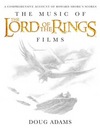Soundtrack Information

The Lord of the Rings: The Return of the King - The Complete Recordings
Release Date: November 20, 2007
Conducted by Howard Shore
Performed by
The London Philharmonic Orchestra
Format: CD
Music By
Purchase Soundtrack
Track Listing
Related Albums
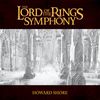
The Lord of the Rings SymphonyHOWE records (HWR-1005)
Released: September 13, 2011
Format: CD (116 min)
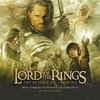
The Lord of the Rings: The Return of the KingReprise (48521)
Released: November 27, 2003
Formats: CD, Digital (72 min)

The Lord of the Rings: The Return of the King - Limited EditionReprise (48560-2)
Released: 2003
Format: CD (72 min)
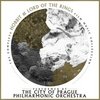
The Complete Hobbit & Lord of the Rings Film Music CollectionSilva Screen
Released: April 24, 2015
Formats: CD, Digital (148 min)
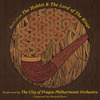
Music from The Hobbit & The Lord of the RingsSilva Screen Records, Ltd.
Released: February 26, 2013
Formats: CD, Digital (65 min)
Review: Lord of the Rings: The Return of the King - The Complete Recordings Info!
5 / 5 Stars
I hardly have to summarize the achievement that the Lord of the Rings trilogy was for Peter Jackson, Howard Shore, and team; the 2004 Oscars did that for me. Culminating in The Return of the King we find ourselves having traveled from an innocent 111th birthday party in the Shire to a full-out, end-of-all-things war. It is an interesting experience to view The Fellowship of the Ring directly after watching The Return of the King to see the stark contrast in the tone of the films. Like the films, Shore\'s thematic elements similarly evolved through the course of the three installments. The Shire theme is relatively simple, both in melody and orchestration; Fellowship of the Ring hinted at other themes (Gondor, Nature, Gollum, etc), but really only saw the development of the Shire, Fellowship, and Ring themes. As The Two Towers introduced and developed the Rohan theme as the primary component to that film\'s story, The Return of the King brings in and develops Shore\'s grand themes for the people of Gondor and Minas Tirith. I will not go into every theme in the film because the task is too daunting, but also because the liner notes do have in-depth discussions of the themes. Rather, this review will talk about the complete recordings, disc-by-disc, and talk about some of the thematic developments in relation to discussions I started in my reviews of The Fellowship of the Ring and The Two Towers.
Even when I say something like "the Ring theme", I am in fact referring to multiple variations for particular elements of the theme\'s use; in this case, I refer to the "History of the Ring" theme, though Shore has a number of musical ideas for the character. All three films open with some sort of flashback that tells us some aspect of the Ring\'s history and fleshes out its themes. Disc 1 opens with "Roots and Beginnings" a smaller scale flashback in comparison to the other films, but no less violent. A number of variations of the Ring themes are woven in and out here as playful hobbit music segues into dark Ring and Gollum themes. This includes a statement of the Ring theme in the trombones toward the end of the cue, an unusual orchestration for the theme, which is normally played on the strings. We also hear the ring\'s Seduction theme, performed by the London Oratory School Schola boy\'s choir, which has been featured in the first films, often accompanying close-up shots of the ring. This eerie tone is an interesting contrast to Shore\'s other use of the boys\' choir, for the Nature theme, representing good and the reclaiming of Mordor-conquered lands.
In "The Road to Isengard", we hear a statement of the rare Quest or setting off theme, heard when Frodo and Sam passed the boundary of the Shire. Then we get a quick succession of theme reprisals, including the Fellowship theme, a hint of the Nature theme, and then the Gondor theme. A bold horn solo backed by low strings highlights out Saruman\'s final scene in "The Foot of Orthanc" along with a few moments of the Isengard orc themes, which was put on the back burner for this film, and a low brass statement of the Gondor theme.
"Return to Edoras" brings us back to familiar territory from The Two Towers with the Rohan theme on the Hardanger fiddle and much of the remainder of Disc 1 accompanies scenes in Edoras. "The Chalice Passed" also refamiliarizes listeners with a series of themes for the Rohan cast as they remember the fallen at Helm\'s Deep. Beginning in The Two Towers, one of my favorite subplots to the trilogy is Theoden\'s rise from a puppet king as one of the tragic stories of the films, but also one of redemption. His growth as a character is also traced musically with the development of the Rohan theme throughout the second film, moving into his major role as the figurehead for Nature\'s Reclamation in this film. The Edoras component ends with "Flight from Edoras" when Gandalf and Pippin charge away. We hear a triumphant statement of the Shadowfax theme (or Gandalf the White) followed by the Fellowship theme on the horn. During the drinking contest scene when Howard Shore makes his one cameo, it is amusing that the brief moment he is on screen, there is not a note of his music being played.
Renee Fleming takes over as the voice of the elves in "The Grace of Undomiel". Her role as a soloist grows throughout this film and her clear, yet warm voice is a perfect accompaniment to both the elves and the finale of the film. This track also includes the first statement of the Minas Tirith theme, when Anduril is reforged, though for the longest time I thought it was the Gray Havens theme, which is similar. This shifts then to the first full statement of the Gondor theme as Gandalf rides into the city. Shore wrote two parts for the Gondor theme, which are often heard one after the other. The Ascension of Gondor is first heard here when the melody rises in a set of triplets. "The Eyes of the White Tower" contains an awesome low brass cue that is easily missed. It is a partially inverted Gondor theme, representing how far Denethor has fallen. Early on in "A Coronet of Silver", we are introduced to a new theme, Gondor Reborn, when Sam and Frodo see the statues of the kings of old. This theme is reminiscent of the Minas Tirith theme and returns in a more triumphant role toward the end of the film.
My favorite piece of music and one of the best written in the past decade ends the first disc. "The Lighting of the Beacons" tells the audience that the set up is over and the film is really about to begin. Racing string lines set a moving underscore for a bold brass theme weaving in and out as the camera flies over the mountains of Middle-earth (aka New Zealand). Jackson showed us how far Gondor had fallen in Denethor\'s hall and now we are seeing hope for its future rise up in the flames of the beacons. Blasted low brass underlie the rising trumpet notes, moving the lines along with staccato triplets. Finally, the building cue breaks out into a triumphant statement of the Gondor theme with a trumpet countermelody. But this lengthy track does not end here. My second favorite cue in the film follows close on its heels. As Theoden decides to ride to Gondor\'s aid, a purely orchestral statement of the Nature\'s Reclamation theme begins, formerly performed by Ben Del Maestro and the boy\'s choir. The quieter moments of the theme underlie Theoden\'s statement: "So it is before the walls of Minas Tirith the doom of our time be decided." Then as the Rohirrim ride out of Edoras, the main part of the theme is performed by the full orchestra for its strongest statement of the trilogy. Disc 1 ends with a final few notes of the Rohan theme at the end, which did not appear in the film.
Disc 2 opens on a dark note with "Osgiliath Invaded". While this cue is primarily dark underscore, there is some really good brass work going on in the background, including some pulsing trombone lines and interesting variations on the Gondor theme. The inverted Gondor theme enters toward the end of the cue on the trombone, signaling the fall of Osgiliath. Then Faramir and his men flee the Nazgul across the plains. A brief Shadowfax theme leads into Galdalf riding out, his staff\'s light driving the Nazgul away. Ben Del Maestro\'s solo is the sound of Gandalf\'s light, first heard in the charge of the Rohirrim at the end of The Two Towers. The cue ends with a final statement of the Gondor theme.
Further development of the Gondor themes continues in "Allegiance to Denethor". The Faramir and Denethor theme is introduced on the flute toward the end. A bold horn line segways into "The Sacrifice of Faramir" which continues the flute theme as a quiet underscore along with choir. A sad Gondor theme accompanies Faramir out of Minas Tirith. Despite the building percussion and Gondor theme, the cue dies out to be replaced by Billy Boyd\'s solo song. This is the second time Shore has opted to score an action sequence with a quiet vocal solo, the first being the Rohirrim charge at the Two Towers finale. It is a more powerful scoring technique than the most blood-pumping action music. A solo violin ends the cue with a brief statement of the Faramir theme.
A great statement of the Rohan theme with the hardanger fiddle playing a counter melody to the horns brings us back to Theoden in "Marshaling at Dunharrow". The statement has a very militaristic tone, signaling the preparations for war. Further variations of the Rohan theme comes in "Master Meriodoc, Swordthain" and "Merry\'s Simple Courage", the latter of which ends the disc. The Minas Tirith theme appears again when Elrond\'s surprising visit delivers Anduril to Aragorn and tells him to use the army of the dead in "Anduril - Flame of the West". A large amount of Disc 2 contains sequences at Cirith Ungol, the paths of the dead, and Shelob\'s lair, which I will not go into depth on here. A quiet Eowyn theme statement is played on a strange sounding violin in "Paths of the Dead" before Aragorn leaves. Then the Fellowship theme makes an appearance when Gimli and Legolas join him, but it is muted. A brief statement of the Minas Tirith theme plays as the trio enter the mountain.
A muted fanfare opens "The Siege of Gondor", the other major cue on Disc 2. Highly varied statement of Gondor themes filter through the pounding action music; war drums play an incessant rhythm through much of the cue. A strong choir comes in halfway through, adding to the epic scale of this battle. The siege continues in Disc 3, opening with "Grond - The Hammer of the Underworld". This cue has some similarities to the rhythms of the Isengard music and maintains the varied and dramatic Gondor thematic statements.
With "The Tomb of the Stewards", the siege shifts to a battle with the timely arrival of Rohan. A high trumpet plays the Gondor theme as Denethor prepares to light his son on fire. This runs into a snare drum beat with a horn statement of the Rohan theme, opening "The Battle of the Pelennor Fields". The Nature theme once again slowly begins to build as Theoden gives his speech to his men. With the words "Now ride! Ride for ruin and the world ending. Forth Eorlingas!" and three cries, Theoden leads the charge at the ranks of orcs laying siege to Minas Tirith as the main Nature theme rises above them. The hardanger fiddle comes back with the Rohan theme over the pounding percussion. Then as the volume rises, the trumpets take over the heroic theme, then a variation of it as the orcs begin to break ranks and the Rohirrim slam into them. This cue, next to "The Lighting of the Beacons", showcases the true talents of the brass players. "The Pyre of Denethor" follows with high brass chords and choir as he screams about no victory. I\'ve found it telling that Denethor runs, burning, off the edge of Minas Tirith and plummets to his death as Jackson pulled back across the Pelennor battle, no one noticing the steward\'s demise.
I return now to the discussion of both Theoden\'s rise and the Nature\'s Reclamation theme. Somewhat of a fatalist, Theoden resigns to his death well before he reaches Minas Tirith, but it does not sway him from charging at the head of the Rohan warriors. The Nature theme is not a major thematic occurrence in the trilogy; Shore saves its use for key moments. These break down into two categories: aid from nature and aid from men. The boy soprano solos characterize the former, beginning with Gandalf\'s call to the eagle from the top of Isengard in The Fellowship of the Ring. The Ents\' march on Isengard saw the full statement of this theme. The latter use of the theme is first hinted at when Boromir rushes to Merry and Pippin\'s aid with the Uruk Hai. The Last March of the Ents cue is then reprised in The Two Towers just before Theoden\'s charge out of Helm\'s Deep, though this is not on the complete recordings album. Now in The Return of the King, the theme is fully orchestrated and performed twice before Theoden\'s charges. His journey goes from Saruman\'s puppet king to the hand of Nature as it moves to reclaim Gondor from the clutches of Mordor. In each of the cases of this theme\'s use, Nature is reclaiming something from Sauron, be it Gandalf, Isengard, Helm\'s Deep, or Gondor.
The battle on the Pelennor fields continues with the arrival of the Mumakil. The short cue features a slow, bold statement of the Rohan theme and is followed by a more aggressive "Dernhelm in Battle" with additional Rohan statements. This cue also features the racing strings and low brass chords from the "Lighting of the Beacons" cue. The action is broken up briefly by Gandalf and Pippin\'s conversation about death in "A Far Green Country" with the first statement of the Gray Havens theme. Eowyn takes over for her uncle in "Shieldmaiden of Rohan", one of the most heroic scenes in the film. A grim chorus enters with the arrival of the Nazgul, followed by heroic brass chords and the Fellowship and Gondor themes. The Beacons orchestrations return again as Aragorn, Legolas, and Gimli arrive and save the day. Then we have "The Passing of Theoden" where the pessimistic yet valiant king, finally redeemed and honor restored, dies. The first and last lines he speaks (as himself) in the trilogy are the same: "I know your face... Eowyn." This cue features a quiet choral dirge and horn solo for the fallen king.
Liv Tyler\'s voice is featured in "The Houses of Healing", a nice song that fits well to the scene, despite the fact that it was not written for it. I do understand why this sequence was cut, however, though it is an appropriate aftermath to the battle. The film then switches gears to the main plot of the trilogy: the Ring. A heroic statement of the Shore them sees Sam to Frodo\'s rescue in "The Tower of Cirith Ungol". The hobbits\' struggle through Mordor continues in "The Land of Shadow", which features very dark statements of the orc themes in the low brass. Bold, angry and dramatic statements of the Ring\'s suite of themes begin to dominate as the Ring is no longer a thing of the past. This continues through into "The Mouth of Sauron". Fellowship and Gondor themes filter through the rhythmic underscore during Aragorn\'s speech to the men of the west. Following this, the tone of the score changes.
Introduced into the finale of the trilogy are new musical elements, including James Galway, Renee Fleming, and solo epic choir. Galway enters first playing a variance of themes on the flute, part Gray Havens, part Shire, but as Frodo cannot recall the Shire at this point, the theme is barely recognizable. When Sam bends to pick Frodo up and carry him, we get a heroic brass statement of the Gray Havens theme, finally breaking through. Disc 3 closes with the epic cue "For Frodo" which opens with a full choral statement of the Fellowship theme that still gives me chills. The chorus dominates the senses, blotting out the meek orchestra playing along beneath it. It\'s second entrance is even stronger with more bass voices added to the mix. The cue ends the disc with the final statement of Nature\'s Reclamation theme as Ben Del Maestro calls the Eagles to attack the Nazgul. A final moment features a strong and sinister Ring theme on a brassy French horn.
There is less to discuss with Disc 4, not just because it is the shortest disc. Jackson added very little footage to the last section of the film because he included all the endings. From the Mount Doom sequence to the end, nothing was added. Additionally, these cues comprised a large percentage of the soundtrack album, relative to the rest of the film, culminating in the lengthy "Return of the King" suite. This is not to say anything bad about Disc 4. It contains some of the best music on the album. All the set up over the course of the trilogy is done with and this final disc includes two important sections of music: the endgame of all three films and the ending summary of all the musical ideas.
Disc 4 moves straight into "Mount Doom". A quiet, eerie opening moves into a cue that did not make it into the extended film, where all three ring themes are played over each other, signaling a turning point in the Ring\'s history; these are the easily recognizable History of the Ring theme, the boy\'s choir Seduction theme, and the creepier Evil of the Ring theme. Then, at the moment when Frodo turns and says "The Ring is mine", the choir kicks in. The full chorus is belting in unison over pounding timpani and low brass line, a truly apocalyptic effect. Then suddenly, Renee Fleming\'s angelic voice is the only sound, the voice of the Ring\'s happiness as Gollum regains possession of it. Her solo is followed by a statement of the History of the Ring theme and the choir enters again. The absolute climax comes a little over a minute into "Crack of Doom" when the Ring is finally destroyed in the fires of Mount Doom. Choir and horns mark the triumphant destruction in a new theme, the Destruction of the Ring. The Gondor Reborn theme then makes a second appearance, this time in a full statement as Barad Dur falls and splits apart. "The Eagles" reprises Renee Fleming\'s haunting vocals.
And the final half hour is the end. "The Fellowship Reunited" features all of the major themes in a lengthy reprisal. We see the return of the Shore and Hobbit themes in their playful statements and only now see how changed the tone of the film had become since Fellowship of the Ring. The Fellowship theme starts off the sequence as each member (minus Boromir) walks in to see Frodo when he wakes. Galway plays a quiet Shire theme which moves into the last statement of the Gondor Reborn theme, truly a triumphant melody, and again the ascending Gondor theme. The best moment in this cue, however, is the breath of fresh air that is the full-orchestra statement of the Shire, the first of its kind - not rushed, not cut off, not varied - in the trilogy, as Aragorn says "You bow to no one". Galway\'s flute takes over as the film winds to a close and the Gray Havens theme begins to dominate with reprisals of the Shire themes. The end titles include a long suite featuring Annie Lennox\'s "Into the West" to the Gray Havens theme and the boys\' choir\'s "Bilbo\'s Song" (written for the fan credits on the extended edition) closes the trilogy.
So, that was a bit longer than I intended. And did you notice how much I didn\'t mention? I hardly have to say this, but this complete recordings set is a must for film score fans, though if you\'re reading this far, you\'ve bought the first two and will buy this one too. There is so much music in the trilogy, and especially in The Return of the King, that went unheard in the film because of loud action sequences, special effects, crying babies, and other distractions. Cues like "Shieldmaiden of Rohan" and "Dernhelm in Battle" seem brand new when heard on album. And of course, the amount of unreleased music here is astounding and a welcome addition to collections, especially the full versions of the charge of the Rohirrim. Fans can finally trace themes through all three films, as I attempted to do for Theoden and Nature\'s Reclamation. Shore\'s thematic complexity and the care in which he wove them through the film is truly stunning. Doug Adams\' liner notes provide extensive explanations of themes complete with examples, written out and times. I also need to say that the performances of the musicians are outstanding. Shore definitely knows how to bring the best out of them.
Editor\'s Note: As with the previous two "Complete Recordings" releases, there is an additional disc, featuring the music in multi-channel audio. For those with regular DVD players, they have a choice of Dolby Digital 2.0 and Dolby Digital 5.1. If you\'re lucky enough to have a DVD-Audio compatible player, then you\'ll probably want to enjoy the score in PPCM high resolution 6-channel sound (though high resolution 2-channel stereo is also provided). Due to space limitations, the DVD is a dual-sided, dual-layer (DVD-18) disc, which means it doesn\'t look as nice or pretty as the previous releases, is more prone to fingerprints and scratches - and even worse, they don\'t label which side is which! Also, the rubber nub holding the disc in place is the same as the past two releases, which can be daunting if you try to just pull the disc off instead of slowly shimmy it off the holder.
Soundtrack.Net Articles
-
Click stars
to rate.
If any information appears to be missing from this page, contact us and let us know!
